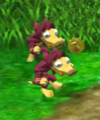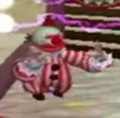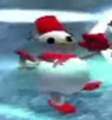Magon: Difference between revisions
mNo edit summary |
Tag: Mobile edit |
||
| Line 72: | Line 72: | ||
|Jap=ピエロン<ref name=P153>「ワリオワールド任天堂公式ガイドブック」 (''Wario World Nintendo Kōshiki Guidebook''), [[media:WW Shogakukan P153.jpg|page 153]].</ref> | |Jap=ピエロン<ref name=P153>「ワリオワールド任天堂公式ガイドブック」 (''Wario World Nintendo Kōshiki Guidebook''), [[media:WW Shogakukan P153.jpg|page 153]].</ref> | ||
|JapR=Pieron | |JapR=Pieron | ||
|JapM= | |JapM=From "{{wp|Pierrot}}" (a term often used synonymously with "clown" in Japanese) and possibly「タマゴン」(''Tamagon'', Magon)}} | ||
;Big | ;Big | ||
{{foreign names | {{foreign names | ||
| Line 84: | Line 84: | ||
|Jap=ユッキ<ref name=P154>「ワリオワールド任天堂公式ガイドブック」 (''Wario World Nintendo Kōshiki Guidebook''), [[media:WW Shogakukan P154.jpg|page 154]].</ref> | |Jap=ユッキ<ref name=P154>「ワリオワールド任天堂公式ガイドブック」 (''Wario World Nintendo Kōshiki Guidebook''), [[media:WW Shogakukan P154.jpg|page 154]].</ref> | ||
|JapR=Yukki | |JapR=Yukki | ||
|JapM= | |JapM=From「雪」(''yuki'', snow)}} | ||
;Big | ;Big | ||
{{foreign names | {{foreign names | ||
| Line 96: | Line 96: | ||
|Jap=ウルップ<ref name=P155>「ワリオワールド任天堂公式ガイドブック」 (''Wario World Nintendo Kōshiki Guidebook''), [[media:WW Shogakukan P155.jpg|page 155]].</ref> | |Jap=ウルップ<ref name=P155>「ワリオワールド任天堂公式ガイドブック」 (''Wario World Nintendo Kōshiki Guidebook''), [[media:WW Shogakukan P155.jpg|page 155]].</ref> | ||
|JapR=Uruppu | |JapR=Uruppu | ||
|JapM= | |JapM=Cropped from「ウルフ」(''urufu'', wolf)}} | ||
;Big | ;Big | ||
{{foreign names | {{foreign names | ||
Revision as of 03:55, January 6, 2022
| A proposal has decided that this page is to be split into the following: Magon, Zombie Magon, Clown, Snowman, Wolf, Miitī, Mummy. (discuss) |
It has been requested that this article be rewritten.
Magons[1][2] are a species of enemies in Wario World, first encountered in Greenhorn Forest. They come in small and large variants; the small Magons can be defeated in one punch, while the large Magons are knocked out in a single punch (or three punches starting in Shivering Mountains) and can then be defeated by picking up and throwing them. The basic form of a Magon seen in the Excitement Central stages is that of a bipedal yellow (for the small type) or orange (for the large type) lizard with a spike on its head. In later stages, Magons take on differently themed appearances to fit the theme of the level Wario is currently in. All large Magons attack Wario with either a claw swipe or with a sliding attack that does no damage, but can cause Wario to drop any enemy or item that he is carrying. Starting in Wonky Circus, they use an additional tail spin attack, which deals a full heart of damage and stuns Wario momentarily. Small Magons do not attack in Greenhorn Forest, merely approaching Wario in large groups and standing near him, but starting in Greenhorn Ruins they may attack Wario with a fast bite attack. In all stages, small Magons also occasionally run away from Wario in fear, eventually disappearing. If Wario defeats a Magon in this state before it disappears, it drops six large coins instead of just one.
Aside from the basic Magons in Excitement Central, other varieties include Zombie Magons[2] in Horror Manor, Clowns[2] in Wonky Circus, Snowmen[2] in Shivering Mountains, Wolves[2] in Beanstalk Way, Miitī in the Mirror Mansion, and Mummies[2] in Pecan Sands. Each Magon derivative gradually attacks at a faster rate than the last iteration.
According to Wario's description of Magons in the Wario World instruction manual, they do not think about "anything whatsoever."[1]
Traits
Magons can spawn with several traits. Physically, they appear in either big or small variants. Big variants follows Wario and try to hit him with his claws and will roar while idle. If there are enemies in the way and they cannot reach Wario, they will taunt Wario with one of their two taunts. They will also learn a tail attack that does more damage starting at Wonky Circus. Only the big variant in Shivering Mountains are the exception to the rule. The small variant follows Wario and will roar and hop in place while idle. They are unable to attack at the start, but will gain a bite on Horror Manor and will keep it for the rest of the game. They get scared and shake in fear after Wario beats other nearby enemies. If they notice they are alone, they will scream and try to run away. If they are beaten while running away, it will drop six big coins, which are each worth ten regular coins. Some will block Wario's path, these will not move and will just taunt at Wario.
The sizes come in two additional behaviors. The clumsy ones sometimes trip on the floor while walking. If a small variant is clumsy, they will look around if they lose sight of Wario and then sprint towards him with their arms raised. They also come in a faster flavor. If a big variant is fast, it can slide in the floor, pushing Wario.
Gallery
Small
Big
Names in other languages
Magon
- Small
| Language | Name | Meaning | Notes |
|---|---|---|---|
| Japanese | タマゴン[3] Tamagon |
Portmanteau of「卵」(tamago, egg) and "dragon" |
- Big
| Language | Name | Meaning | Notes |
|---|---|---|---|
| Japanese | ビッグタマゴン[3] Biggu Tamagon |
Big Magon |
Zombie Magon
- Small
| Language | Name | Meaning | Notes |
|---|---|---|---|
| Japanese | 骨ゴン[4] Honegon |
Portmanteau of「骨」(hone, bone) and「タマゴン」(Tamagon, Magon) |
- Big
| Language | Name | Meaning | Notes |
|---|---|---|---|
| Japanese | ビッグ骨ゴン[4] Biggu Honegon |
Big Zombie Magon |
Clown
- Small
| Language | Name | Meaning | Notes |
|---|---|---|---|
| Japanese | ピエロン[5] Pieron |
From "Pierrot" (a term often used synonymously with "clown" in Japanese) and possibly「タマゴン」(Tamagon, Magon) |
- Big
| Language | Name | Meaning | Notes |
|---|---|---|---|
| Japanese | ビッグピエロン[5] Biggu Pieron |
Big Clown |
Snowman
- Small
| Language | Name | Meaning | Notes |
|---|---|---|---|
| Japanese | ユッキ[6] Yukki |
From「雪」(yuki, snow) |
- Big
| Language | Name | Meaning | Notes |
|---|---|---|---|
| Japanese | ビッグユッキ[6] Biggu Yukki |
Big Snowman |
Wolf
- Small
| Language | Name | Meaning | Notes |
|---|---|---|---|
| Japanese | ウルップ[7] Uruppu |
Cropped from「ウルフ」(urufu, wolf) |
- Big
| Language | Name | Meaning | Notes |
|---|---|---|---|
| Japanese | ビッグウルップ[7] Biggu Uruppu |
Big Wolf |
Miitī
- Small
| Language | Name | Meaning | Notes |
|---|---|---|---|
| Japanese | ミイティー[8] Mītī |
Possibly a combination of「ミッテン」(mitten, mitten) and「キティー」(kitī, kitty) |
- Big
| Language | Name | Meaning | Notes |
|---|---|---|---|
| Japanese | ワンスル[8] Wansuru |
From「ワンワン」(wanwan, onomatopoeia for a dog's barking) and possibly「するする」(surusuru, an adverb for "swiftly") |
Mummy
- Small
| Language | Name | Meaning | Notes |
|---|---|---|---|
| Japanese | ミミック[9] Mimikku |
From「ミイラ」(miira, mummy) and possibly "mimic" |
- Big
| Language | Name | Meaning | Notes |
|---|---|---|---|
| Japanese | カイロネ[9] Kairone |
From "Cairo" and possibly「ね」(-ne, Japanese name ending) |
References
- ^ a b Wario World instruction booklet, page 24 (British English) or page 30 (American English).
- ^ a b c d e f Stratton, Steve. Wario World: Prima’s Official Strategy Guide. Page 13.
- ^ a b 「ワリオワールド任天堂公式ガイドブック」 (Wario World Nintendo Kōshiki Guidebook), page 151.
- ^ a b 「ワリオワールド任天堂公式ガイドブック」 (Wario World Nintendo Kōshiki Guidebook), page 152.
- ^ a b 「ワリオワールド任天堂公式ガイドブック」 (Wario World Nintendo Kōshiki Guidebook), page 153.
- ^ a b 「ワリオワールド任天堂公式ガイドブック」 (Wario World Nintendo Kōshiki Guidebook), page 154.
- ^ a b 「ワリオワールド任天堂公式ガイドブック」 (Wario World Nintendo Kōshiki Guidebook), page 155.
- ^ a b 「ワリオワールド任天堂公式ガイドブック」 (Wario World Nintendo Kōshiki Guidebook), page 156.
- ^ a b 「ワリオワールド任天堂公式ガイドブック」 (Wario World Nintendo Kōshiki Guidebook), page 157.














